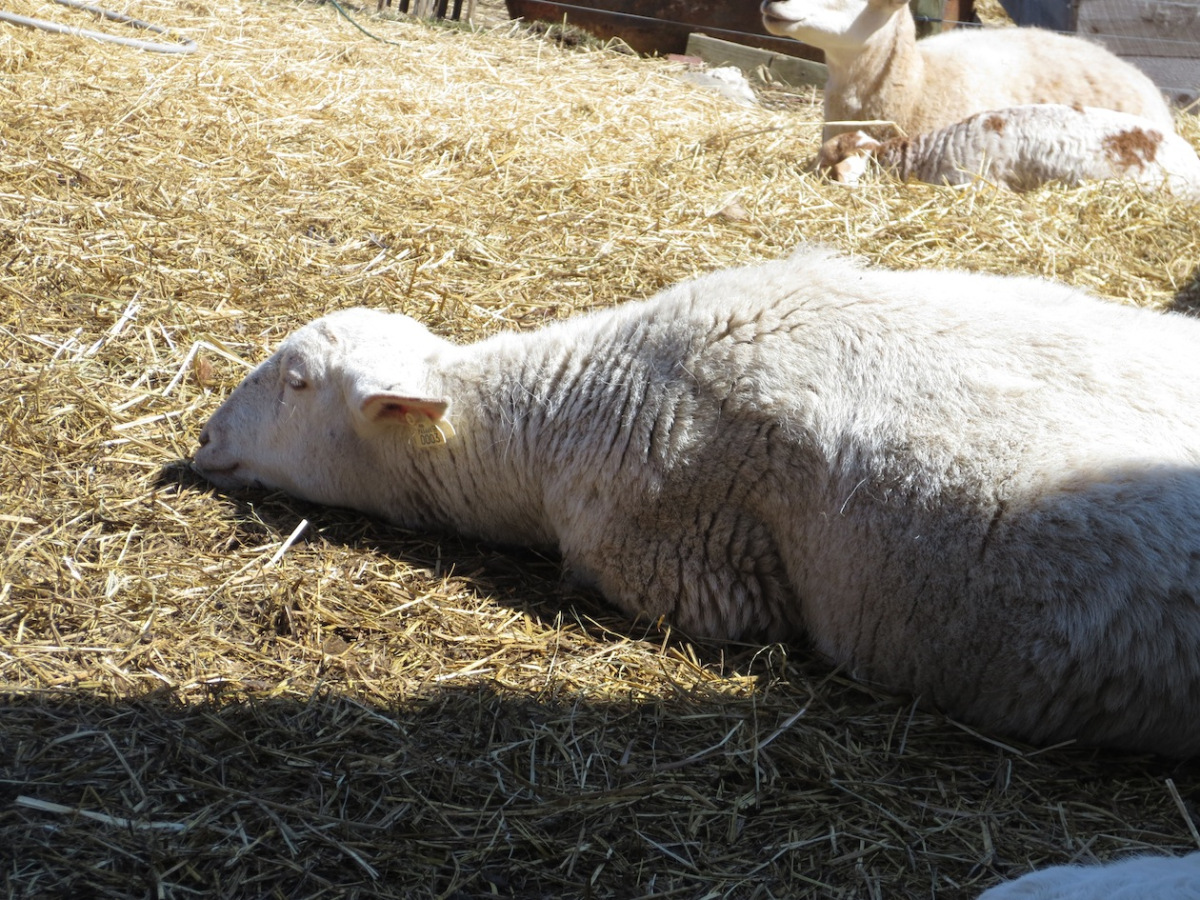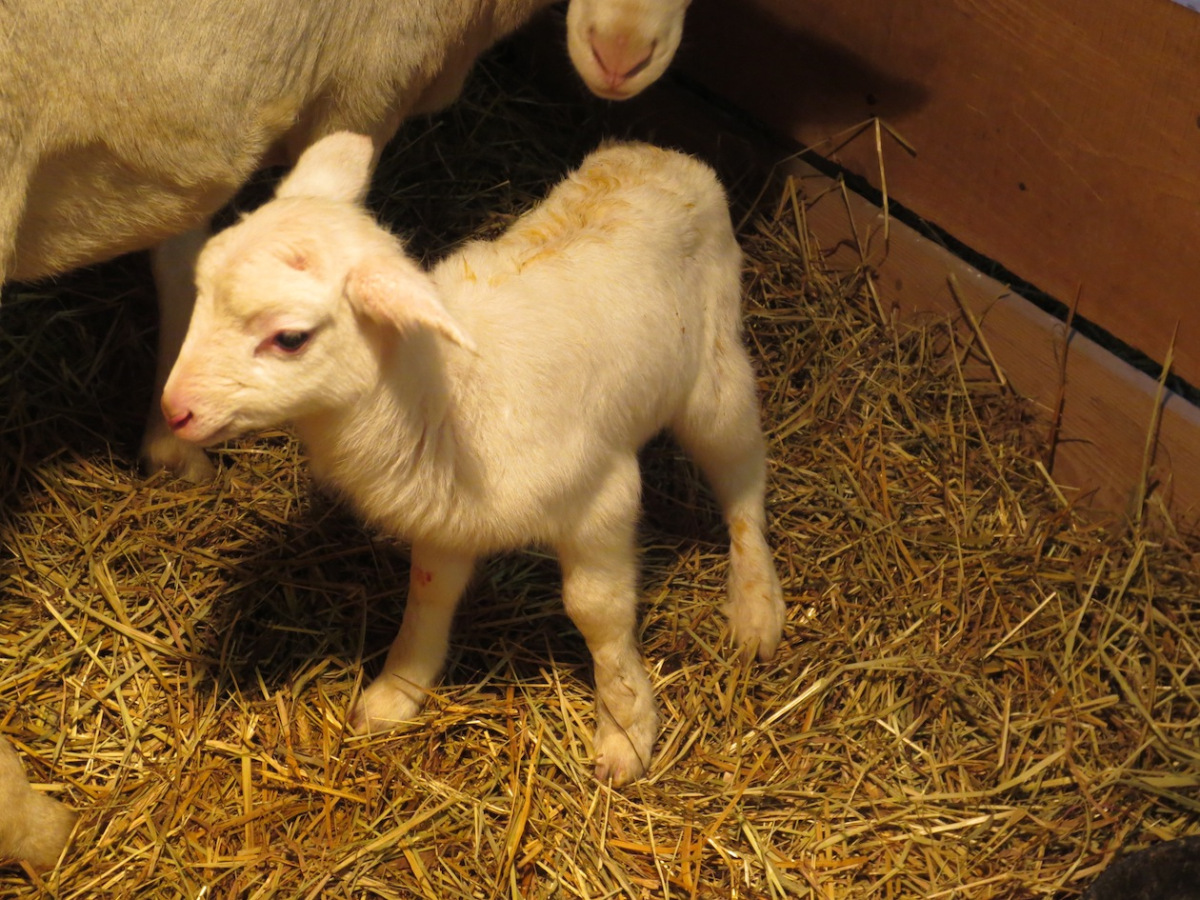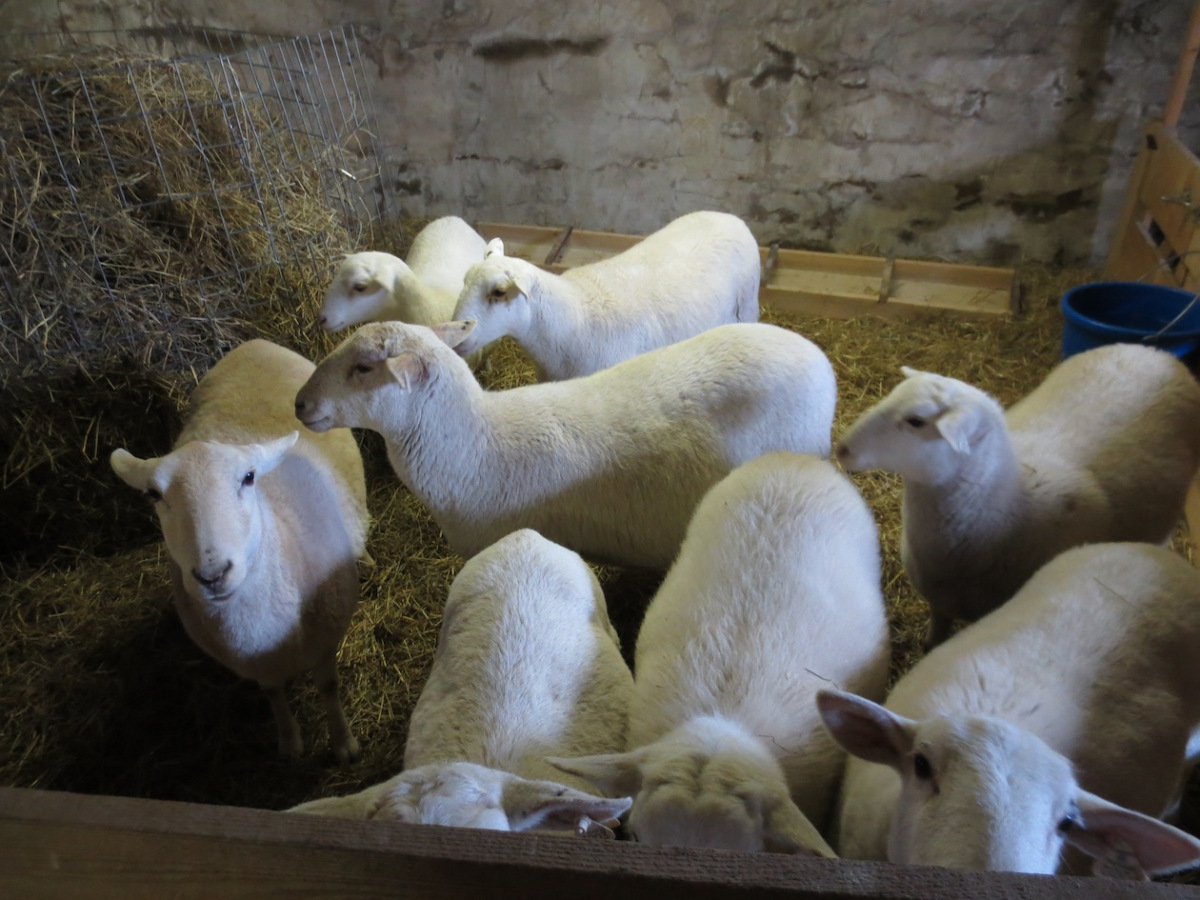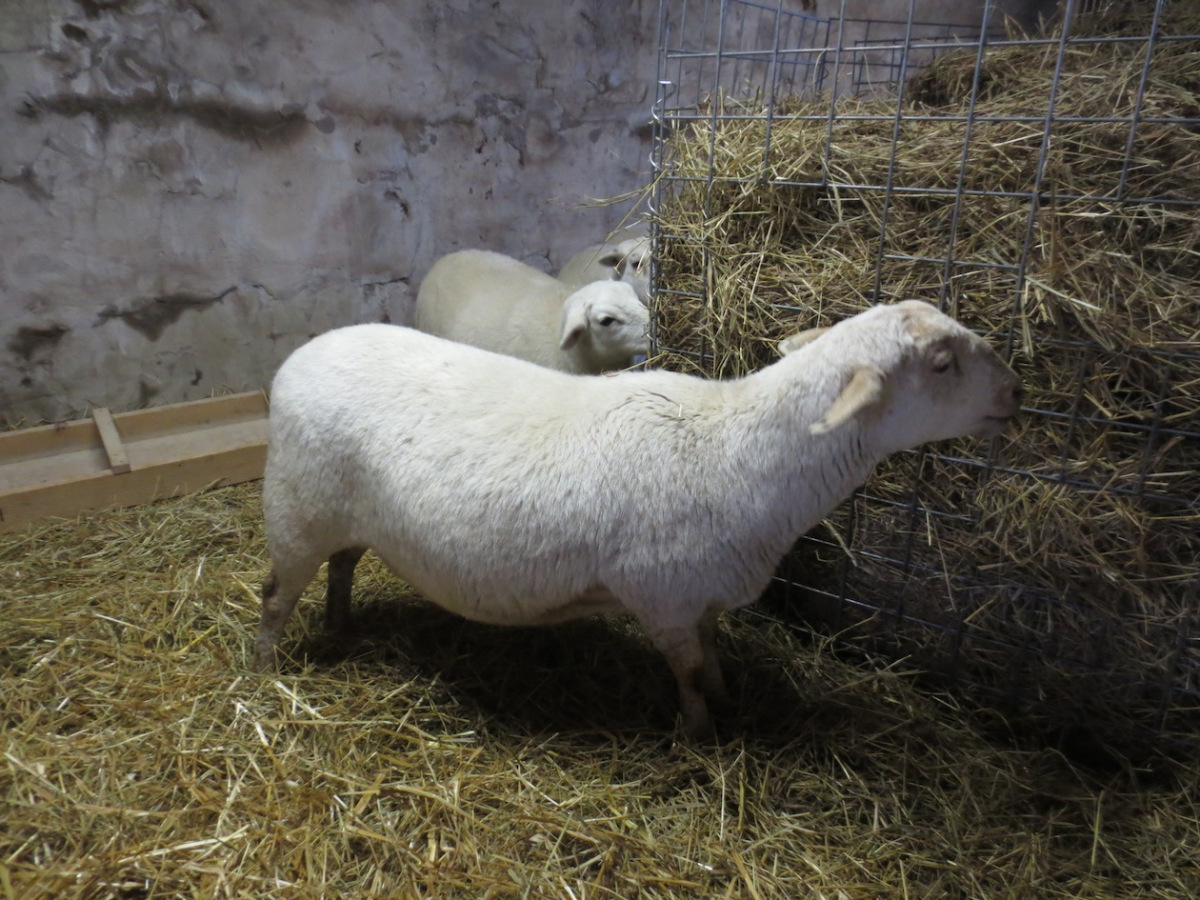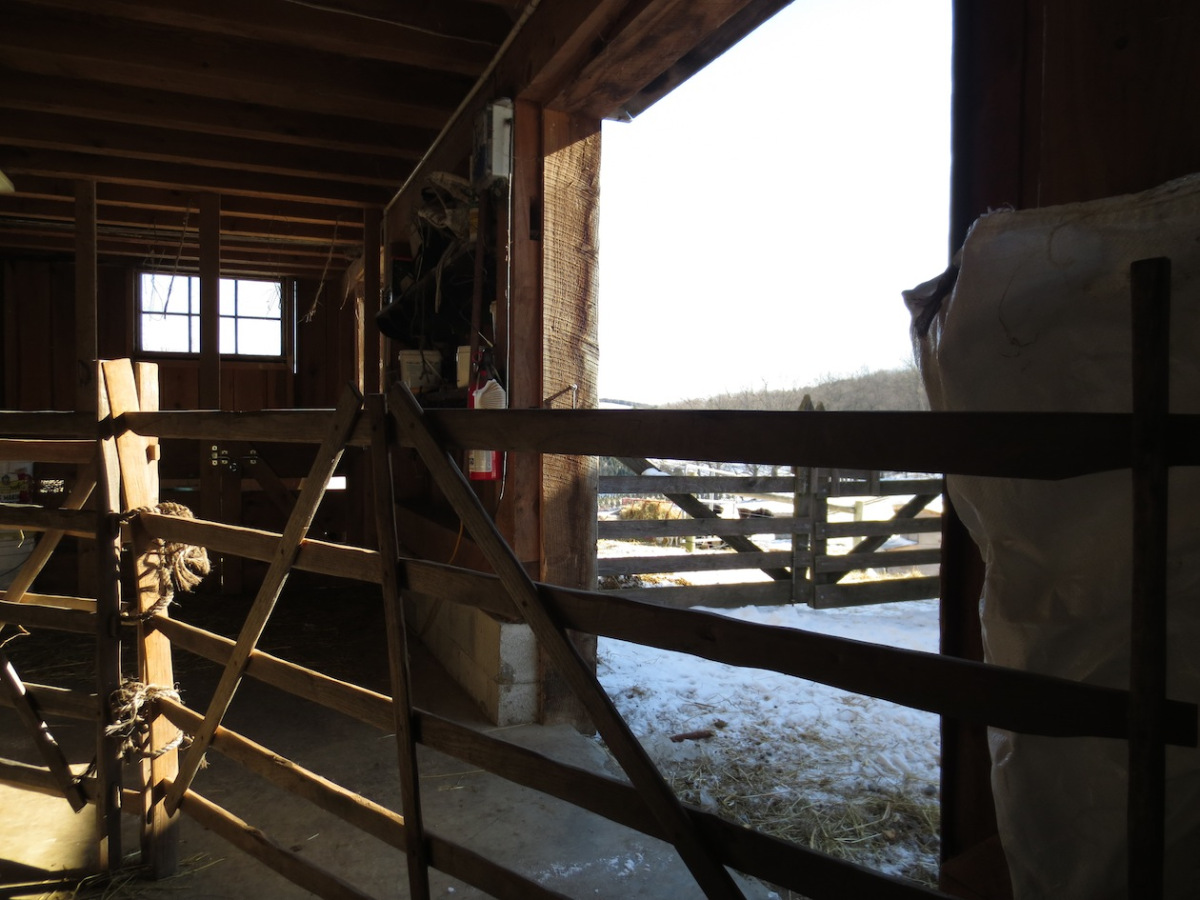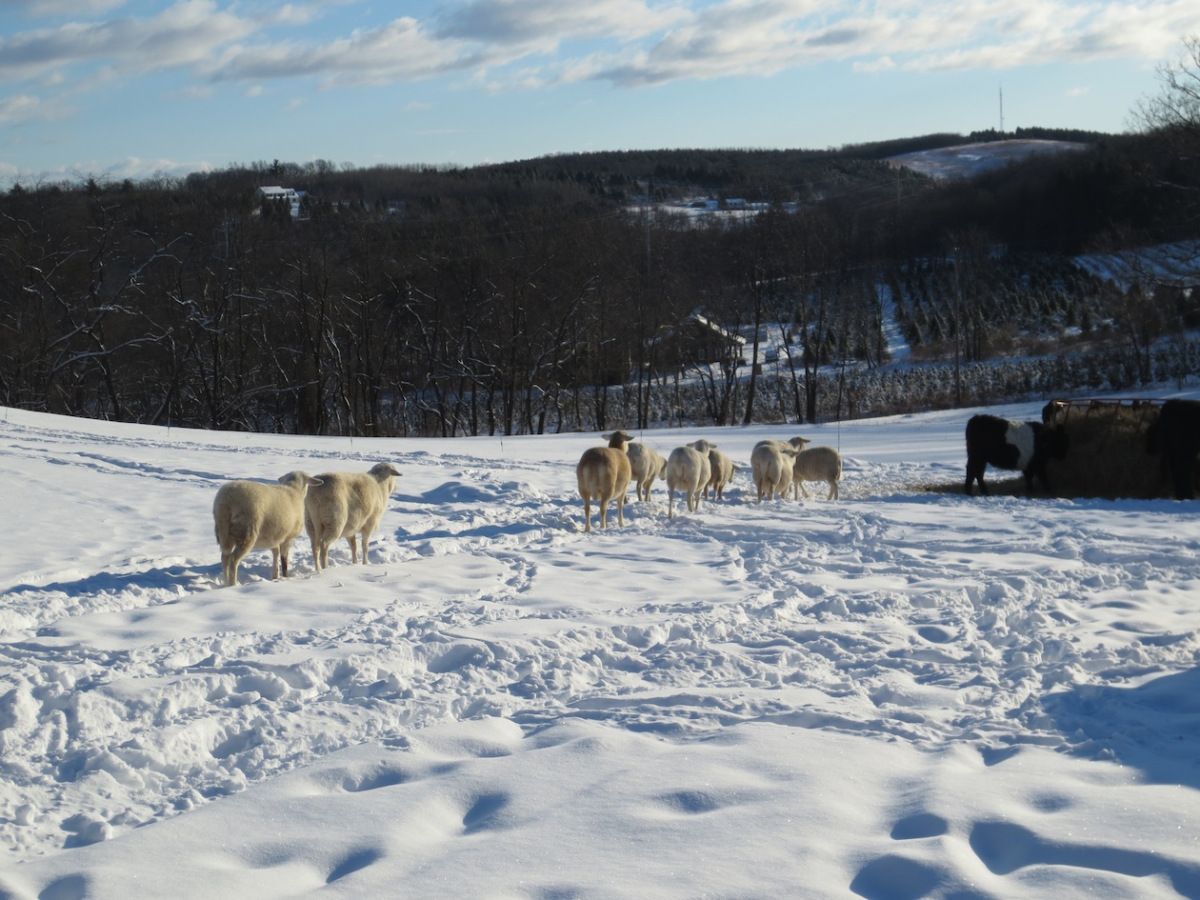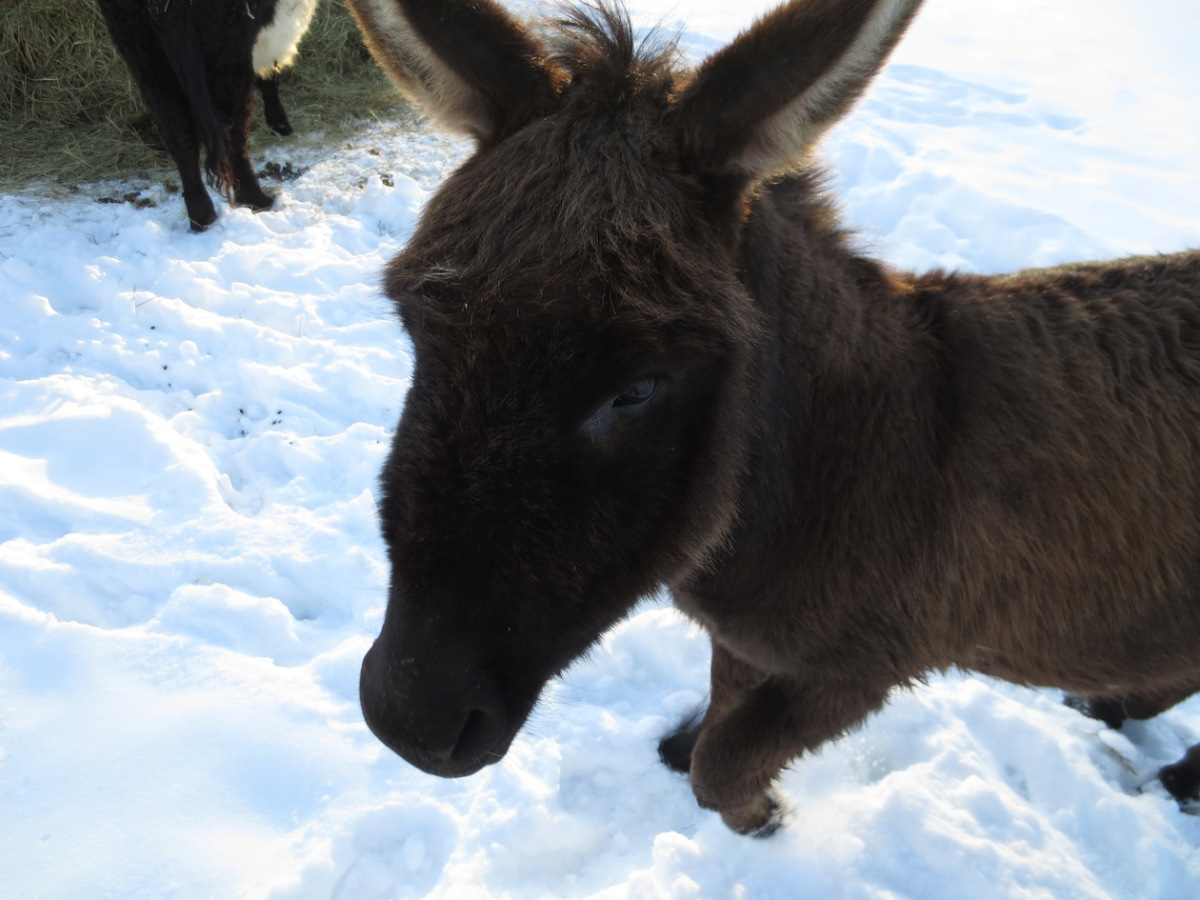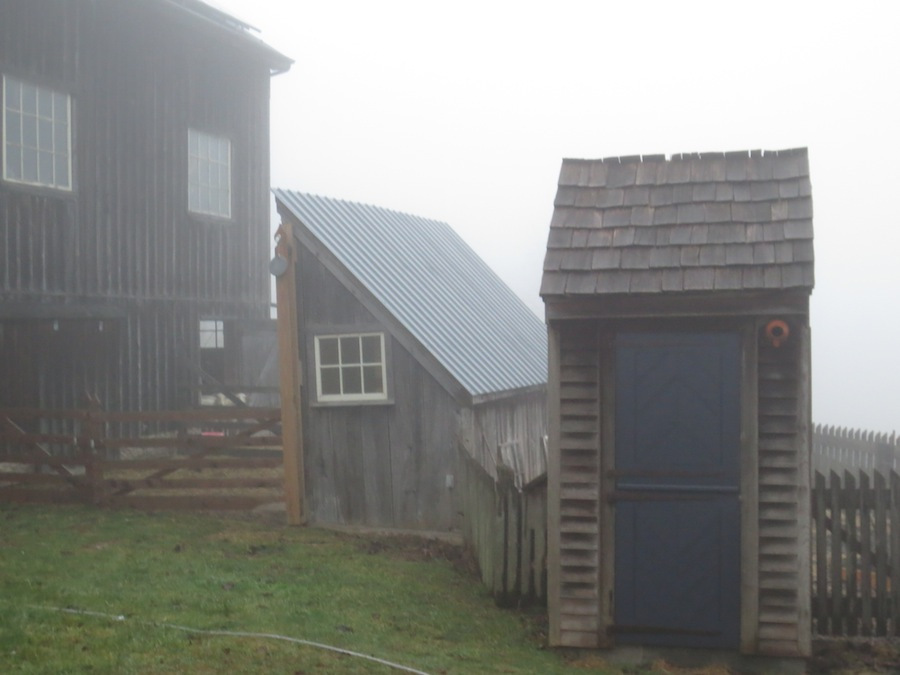I believe that lambing is finally done. On Saturday morning I found 006 with her dry and full bellied ewe lamb in the goat paddock. Continuing with the Shakespearean theme, we named her Hero. Her left ear is brown. Since Hero was born outside she has a bit of dirt on her face, probably from the "nest" her mother scratched into the ground.Like this year's mothers, 006 is an attentive mother, protecting her lamb by tucking the lamb behind her when a stranger approaches, nickering to her lamb when the flock is near and keeping Hero's belly full.
Temporary bale feeder in barnyard
So the lactating ewes and their growing lambs can eat as much hay as they need, I cobbled together a round bale feeder for the sheep's barnyard. Tucked into the corner made by the baryard gate and the barn wall, and sided by a pallet and cattle panel, the sheep have access to the hay.
Ramling with the flock
On the weekend I moved the ramling and 005 back with the flock. Like her flockmates, 005 keeps her lamb near her side by calling to him with those deep "new mama" grunts . When he wanders a bit too far she noses him into place by her side.
A ram lamb
005 sought the barnyard stall, pawed a nest in the straw and lambed this morning.She avidly licked her ram lamb dry and he was soon noisily nursing.
And still we wait for lambs
Four of our Katahdins have not lambed. These four sheep are "theaves"( Theave or theaf (plural of either: theaves) – a young female sheep, usually before her first lamb (used especially in lowlandEngland). Also gimmer.), first timers.These two girls, 005 and 006 are showing signs that they are nearing the end of their pregancies. In addition to physical changes, their behavior has changed and their usual reserve has been replaced with friendliness.Verbena and her sister Viola do not show the physical changes associated with late pregnancy. I pulled Burgess from the ewes in January so they could lambs as late as June, if they are bred.
So, my shepherd's mind is whirling. If they did breed, why so late? If they are not bred, why not? They could have been a bit young when l put Burgess in with the ewes so perhaps, if bred, their lambing date is more in tune with their age.These girls are from Mab, one of my first and favorite ewes. She is not skittish, has a large, deep body, and has lambed every year without trouble; I want her genetics in my flock.
Do I give them another year or do I cull?
Katahdin Mauve beginning to shed
With her dark coat,it is easy to see that Mauve is starting to shed.
Sunbathing sheep 3/30/13
Vaccinating, banding and weighing the lambs
Today we vaccinated the lambs with their first Clostridium Perfringens Types C & D-Tetnus Toxoid shots. We will revaccinated in three to four weeks. According to www.sheepandgoat.com:
Enterotoxemia is caused by the bacteria Clostridium perfringins, which is a normal inhabitant of the animal's gut, but can proliferate to toxic levels under certain circumstances. Type C, also called bloody scours or lamb dysentery, usually affects lambs and kids during the first few weeks of life. It is usually precipitated by an increase in feed, such as the start of creep feeding or increased milk availability due to loss of a littermate. Type D, more commonly called overeating disease (and also pulpy kidney disease), affects lambs and kids that are typically over one month of age. Overeating occurs with a sudden change in feed and is associated with high concentrate feeding.
Tetanus, also known as "lockjaw" occurs when the bacteria causing it, Clostridium tetani, gains entry through an open wound or contaminated skin break and proliferates to toxic levels.
The unbanded ram lambs were banded as well.
The two to three week old lambs weighed in at 17 - 25 pounds.
March 25, 2013
Undeterred by Puxsutawney Phil's predictions for an early spring, snow has been falling all morning. In spite of its inconvenience, I do perfer this light snow to last year's unseasonablely early spring.
With the wethers and ram out of the barn and across the road, I move the ewes and lambs into the barnyard daily. Within the confines of the barn, the lambs learn to move with the flock from the ewes' pen, through the temporary corridor, to the barnyard stall and then the barnyard. The first moves were loud, with ewes calling to their lambs as they made the trip to the outside. After a few days of practice the flock moves as a whole, lambs jostling along as a group and rubbing against their mothers once they reach the barnyard. For our rotational grazing during the green seasons, a flock that moves well together is an asset. This mild, windless day seemd a perfect time to intorduce the lambs to snow.
Boys to the Bachelor Field
With a forkful of hay and a scoop of grain we we able to lead the boys to the field across the road. Moving the boys to the secure field frees up the stall open to the barnyard. Initially the boys had twice daily wheelbarrow hay deliveries. Now they have the round bale feeder from the ewe's pen.They do love to nose around the farthest reaches of the pen.
Two new lambs
Yesterday Mab finally had her lamb. In spite of her girth, a single ram, a 10#at that. She is such an excellant mother I was hoping for a ewe lamb but her ramling is strong and healthy. Mother sheep nuzzle lambs behinds to encourage new lambs to nurse.
This morning a ewe lamb from Owens 13. Like her mother, Beatrice has long legs.On its first day, a new lamb shakily kneels, front feet first, then, tucks in each back leg, then a snooze,
Maude's twin lambs
This morning's peek over the ewe pen gate revealed Maude with pair of white, curly lambs. By the time they were discovered, they were almost dry and full bellied.Portia and Paxton weighed in at 7.5 pounds each. I am especially relieved to see that Maude's lambs are strong and well formed;last year's twins were weak and died early.Mauve and dappled Hugh left the lambing jug to make room for the new family. Hugh's intoduction to the flock was accompanied by Mauve's nickers and protection.
First lamb of the season
After a night of dreaming of lambs I found Mauve in the ewe pen with her own spotted ram lamb before dawn. He was already cleaned off and she was nickering to all 8 pounds of him. Mauve is from the first batch of ewes we bought from Dave Hartman. In spite of losing her lamb last year, Mauve knows how to care for her lamb. Mauve is my wildest ewe.Hopefully I can calm her by handling her lamb while they spend time time in the lambing jug.
A winter break
Lilac Hill farm in late winter is all about food, water, shelter and waiting. Waiting for kids and lambs, waiting for nest making and eggs, and waiting for the first bits of green in the pastures. Already the days have lengthened and evening chores are not completed in the dark.
In spite a false alarm when I was away from the farm for 6 days, Gretel waited to kid until the week after my return.On Sunday the 24th Gretel kidded. Ernest (6#) and Cecily (8#) arrived without complications. Unfortunately Gretel's colostrum was too thick for them to nurse so we thinned the milked colustrum and bottle fed it to the Wilde kids (my daughters' name choices were inspired by Ocsar Wilde's "The Importance of Being Ernest") in front of a warming fire. The kids spent the first night in the house then were returned to the barn. All this intervention was guided by our friend, Mike, with years of goat experience and who just happened to come to dinner on Sunday. Gretel came from Mike's farm years ago.
Although we do not see the Wilde kids nurse, they do have milk in their bellies and are very active.
The Katahdin ewes have benefitted from a grain ration at the end of their pregnancies. At the end of January I noticed that the ewes, especialy the yearlings (also know as theaves or gimmers), were losing condition on a hay only diet.Because I needed to put the ram in with the ewes a month early last fall (Burgess' field companion died unexpectedly), the yearlings needed the added nutritional support as they continue to grow while pregnant. Daily, close contact, especially with delicious grain, has gentled the flock and even my shiest Katahdins tolerate closer handling. The older two ewes, Maude and Mab, are obviously getting ready to lamb. It is harder to judge the readiness of the theaves.
A break in the weather
With yesterday's warming (and sleet and rain and mist) running water returned to the barn hydrant.
To avoid sore feet or twisted legs, I will keep the pregant girls, the ewes and Gretel, in the barn. The ram and wethers will stay have access to the barnyard, but not the field with Murphy, the donkey and the Belties. With warming on the way and mud in my future, I will get a round bale out to the cows today.
The new batch of round bales are heavier and mostly Timothy. The larger bales last alot longer limiting skid steer traffic and during the coldest temperatures and the last weeks of pregnancies,when nutritional needs are high, my animals benefit.
Arctic Blast
The last week has found us in the clutches of bitter temperatures. When the temperatures dip into the single digits my barn water hydrant freezes and the frozen waterfowl troughs become too heavy to dump. Fortunately the hydrant in the boat barn is reliable and uphill from the heated field trough so draining the hose after use is easy. Until the duck and goose "ponds" melt a bit, the fowl must be content with buckets of water drawn from the cow and donkey trough. I placed the round bale of hay closer to the hill to provide northly protection from the wind.With the Katahdins and Gretel nearing the end of their pregnancies, I have changed my management practices. Gretel's earliest due date is in the middle of February. She overnights in the goat pen to avoid excess jostling and eats her portion of grain without competition. During the day she roams the barnyard for exercise, eats hay from the round bale feeder and lies in the sun. The ewes now overnight in a paddock fashioned at the bottom of the barn with two pen specific gates and two panels from the trailer pen.The ewes have two 8' troughs set up along the back wall of the barn for their portion of grain. With 16' of trough there is plenty of room for all the ewes to eat without competition. A much distressed Burgess now beds down and eats with the wedding wethers. During the coldest nights I keet the sheep and goats closed in the bottom of the barn. I set up the 4 hurdles as a moveable chute for guiding the ewes and goat away from the bins of grain and out to the paddock. In spite of the frigid temperatures I keep the sheltered door open during the day to welcome in the sun.
Becoming a shepherd is a humbling endeavor. It requires that I observe the sheep, looking for clues to conditions I often do not know exist. For example, I noticed that the yearlings' bellies were rounding, but missed that their condition score was dropping until I ran my hand along their bumpy spines. According to the advice of my books I had planned on starting to feed grain during the last week of January but, experience would have told me to start a week or two earlier. As LHF grows, so will our handling facilities. With more secure fenced fields I will be able separate the yearlings for later breeding dates, to avoid stressing their growing bodies with early first lambings. As my flock grows, staggered lambing dates will also allow me to use the pens that I have without overcrowding. My winter reading list reflects my deficiencies as a shepherd. I have been reading about nutrition and the types of hay best suited to the needs of the sheep, hoping that I will know what to look for when looking at a field ready to be cut and a round bale offered for sale. At a workshop sponsored by Fertrell's I paid particular attention to the talk about feeding small grains to rumninants. I have also been reading about lambing and watching youtube videos to refamiliarize myself with lambing-normal and troubled. Hopefuly when faced with an unexpected problem I will be able to manage and add another "thing" I notice as I tend my sheep.
January 11th, A Beautiful Barnyard Morning
The following post is not an effort to call out Murphy, not our donkey, and his fatalistic "Law" but to note my appreciation for a morning spent doing barnyard chores.
On a windless morning with choretime temperatures in the midthirties, I was hatless as I feed and watered the livestock. The long black hose, that reaches all the way to the goose trough, unrolled easily without its usual frozen stiffness. With a few days of temperatures above freezing and nights not far below, the barnyard is neither an unforgiving, frozen tract nor a sucking, muddy mess making the transfer of waste hay stems to slick or muddy spots easy. While moving forkfuls of the fluffy waste I had time to watch the animals, especially the Belties and Murphy as they investigated my work and the vacated sheep pens. Today I released the wedding sheep from the goat yard. I want them to get more exercise and get accustomed to the ram because they will be penned together when the ewes go into the lambing barn. Murphy hopped into the empty goat stall through its small, barnside door and snuffled around in search of stray grain. Each of the Belties took turns watching longingly with ony room for a black curly head through the hatch. While the cattle and donkey nosed around the barnyard the wedding sheep blended easily to the flock clustered around the hay filled round bale feeder.Hopefully without the intereference of the often present Murphy's Law, I will be able to sort the wedding sheep during evening chores and get them back in their pen for their supplement of grain.
Winter Hay Feeding
Once colder nights arrived I stopped carrying forkfuls of hay twice daily and put a round bale into the feeder.The Belties have 24 hour access to the hay. At first, the Belties and Murphy the donkey were very territorial about the hay feeder, pushing and shoving for position.
As the Katahdins trekked to the feeder Murphy would stand guard and a flick of his ear could dissuade the line of sheep from feeding.Now that there are mutiple circles of trampled hay waste dotting the field and the animals have accustomed themselves to eachother, the sheep eat their fill and head back to the barn for a rest.
December flock observations
While doing the morning chores I had time to watch the Katahdins. For Lilac Hill their strong flocking behavior makes them easy to handle, moving as a group around pastures and through gates. While at rest or grazing they do seem to have preferred buddies. Queen Mab, the calmest of our first ewes on the farm, prefers the company of her daughters. She often stands aside to watch the flock. Like Mab, her daughters are calm and friendly.Mauve and Maude, also from our first set of ewes although not has calm as Mab, are barnyard friends. Maude, who adopted Marilla's orphans in the spring, has recently switched her attentions from the orphans to Mauve.
In the farm book Marilla's twins have names but since they are shy,stick together and avoid human contact, I usually think of them as "the twins". Their sire was of questionable quality so any offspring will not enter the our breeding flock and I will be watching their performance this year. Hopefully they will pass on the strengths of the Katahdin breed.Owen's 13 is a calm ewe lamb from nearby Owen's farm and does not have a particular companion.
I found lambing season gentles the ewes. I the few weeks preceding lambing I confine the ewes to the barn and barnyard. The ewes get accustomed to my comings and goings in close quarters as I do the barn chores and nighttime barn checks. After lambing, when a ewe is in the lambing jug with her new lambs, I can give individual attention to the skittish ewes and get acquainted with the lambs.
Burgess
Two month old Burgess is one of a triplet, raised as a twin. His torso is long and his leg is substantial. He is a rather delicate grazer, pulling dried clover flowers one by one with purposeful determination that will surely get the pasture grazed completely.














